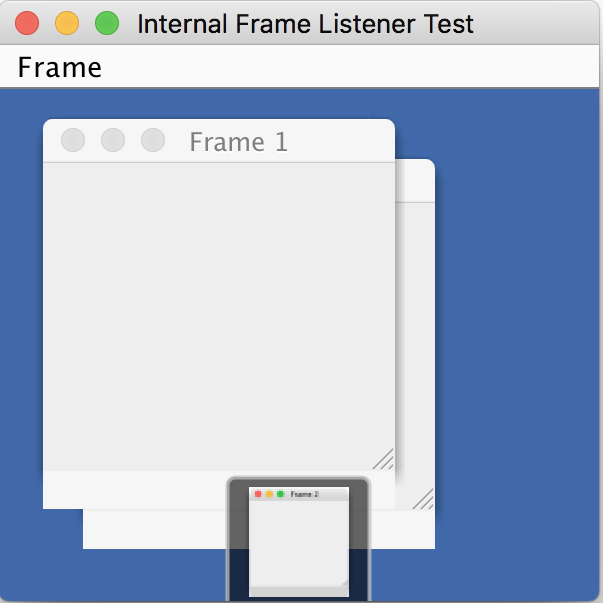Java Swing Tutorials - Herong's Tutorial Examples - v4.32, by Herong Yang
javax.swing.InternalFrameListener - Internal Frame Listener Interface
This section provides a tutorial example on how to use javax.swing.JInternalFameListener interface that allows implementing classes to handle internal frame events.
The following program shows you how to create internal frame listeners:
/* JInternalFrameListenerTest.java
* Copyright (c) 1997-2024 HerongYang.com. All Rights Reserved.
*/
import java.awt.*;
import java.awt.event.*;
import javax.swing.*;
import javax.swing.event.*;
public class JInternalFrameListenerTest
implements InternalFrameListener, ActionListener {
JFrame myFrame = null;
int count = 0;
public static void main(String[] a) {
(new JInternalFrameListenerTest()).test();
}
private void test() {
myFrame = new JFrame("Internal Frame Listener Test");
myFrame.setDefaultCloseOperation(JFrame.EXIT_ON_CLOSE);
myFrame.setSize(300,300);
myFrame.setContentPane(new JDesktopPane());
JMenuBar myMenuBar = new JMenuBar();
JMenu myMenu = new JMenu("Frame");
JMenuItem myMenuItem = new JMenuItem("New");
myMenuItem.addActionListener(this);
myMenu.add(myMenuItem);
myMenuBar.add(myMenu);
myFrame.setJMenuBar(myMenuBar);
myFrame.setVisible(true);
}
public void actionPerformed(ActionEvent e) {
count++;
JInternalFrame f = new JInternalFrame("Frame "+count);
f.setResizable(true);
f.setClosable(true);
f.setMaximizable(true);
f.setIconifiable(true);
f.setSize(200,200);
f.setLocation(count*10,count*10);
f.addInternalFrameListener(this);
f.setVisible(true);
myFrame.getContentPane().add(f);
}
public void internalFrameActivated(InternalFrameEvent e) {
System.out.println("Internal frame activated");
}
public void internalFrameClosed(InternalFrameEvent e) {
System.out.println("Internal frame closed");
}
public void internalFrameClosing(InternalFrameEvent e) {
System.out.println("Internal frame closing");
}
public void internalFrameDeactivated(InternalFrameEvent e) {
System.out.println("Internal frame deactivated");
}
public void internalFrameDeiconified(InternalFrameEvent e) {
System.out.println("Internal frame deiconified");
}
public void internalFrameIconified(InternalFrameEvent e) {
System.out.println("Internal frame iconified");
}
public void internalFrameOpened(InternalFrameEvent e) {
System.out.println("Internal frame opened");
}
}
Run this program, you will see a blank frame with one menu called "Frame". If you:
- Click "Frame" menu and "New" menu item to create first internal frame.
- Click "Frame" menu and "New" menu item to create second internal frame.
- Click the close icon on the first internal frame.
- Click the maximize icon on the second internal frame.
- Click the minimize icon on the second internal frame.
- Click the minimized image of the second internal frame.
you will see the following messages generated from the internal frame listener methods.
Action performed - Clicked "New" menu item Internal frame opened Action performed - Clicked "New" menu item Internal frame opened Internal frame closing - Clicked the close icon Internal frame closed Internal frame activated - Clicked the maximize icon Internal frame deactivated - Clicked the minimize icon Internal frame iconified Internal frame activated - Clicked the minimized image Internal frame deiconified
At the end of the test, the main frame will look like this:

Table of Contents
Introduction of Java Swing Package
Graphics Environment of the Local System
JCheckBox - Swing Check Box Class
JRadioButton - Swing Radio Button Class
JTextField - Swing Text Field Class
JComboBox - Swing Combo Box Class
Menu Bar, Menus, Menu Items and Listeners
►Creating Internal Frames inside the Main Frame
javax.swing.JInternalFame - Internal Frame Class
JInternalFameTest.java - Internal Frame Class Test
►javax.swing.InternalFrameListener - Internal Frame Listener Interface
Layout of Components in a Container
JEditorPane - The Editor Pane Class
SwingWorker - The Background Task Worker
AWT (Abstract Windows Toolkit)